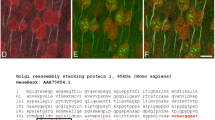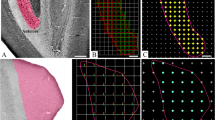Abstract
During hibernation, mammals like the 13-lined ground squirrel cycle between physiological extremes. Most of the hibernation season is spent in bouts of torpor, where body temperature, heart rate, and cerebral blood flow are all very low. However, the ground squirrels periodically enter into interbout arousals (IBAs), where physiological parameters return to non-hibernating levels. During torpor, neurons in many brain regions shrink and become electrically quiescent, but reconnect and regain activity during IBA. Previous work showed evidence of extracellular matrix (ECM) changes occurring in the hypothalamus during hibernation that could be associated with this plasticity. Here, we examined expression of a specialized ECM structure, the perineuronal net (PNN), in the forebrain of ground squirrels in torpor, IBA, and summer (non-hibernating). PNNs are known to restrict plasticity, and could be important for retaining essential connections in the brain during hibernation. We found PNNs in three regions of the hypothalamus: ventrolateral hypothalamus, paraventricular nucleus (PVN), and anterior hypothalamic area. We also found PNNs throughout the cerebral cortex, amygdala, and lateral septum. The total area covered by PNNs within the PVN was significantly higher during IBA compared to non-hibernating and torpor (P < 0.01). Additionally, the amount of PNN coverage area per Nissl-stained neuron in the PVN was significantly higher in hibernation compared to non-hibernating (P < 0.05). No other significant differences were found across seasons. The PVN is involved in food intake and homeostasis, and PNNs found here could be essential for retaining vital life functions during hibernation.






Similar content being viewed by others
References
Arena ET, Rueden CT, Hiner MC, Wang S, Yuan M, Eliceiri KW (2017) Quantitating the cell: turning images into numbers with ImageJ. Wiley Interdiscip Rev Dev Biol 6:e260
Balmer TS, Carels VM, Frisch JL, Nick TA (2009) Modulation of perineuronal nets and parvalbumin with developmental song learning. J Neurosci 29:12878–12885
Bratincsak A, McMullen D, Miyake S, Toth ZE, Hallenbeck J, Palkovits M (2007) Spatial and temporal activation of brain regions in hibernation: c-fos expression during the hibernation bout in thirteen-lined ground squirrel. J Comp Neurol 505:443–458
Brückner G, Hausen D, Härtig W, Drlicek M, Arendt T, Brauer K (1999) Cortical areas abundant in extracellular matrix chondroitin sulphate proteoglycans are less affected by cytoskeletal changes in Alzheimer’s disease. Neuroscience 92:791–805
Buijs R, Pévet P, Masson-Pévet M, Pool C, De Vries G, Canguilheim B, Vivien-Roels B (1986) Seasonal variation in vasopressin innervation in the brain of the European hamster (Cricetus cricetus). Brain Res 371:193–196
Cabungcal J-H, Steullet P, Morishita H, Kraftsik R, Cuenod M, Hensch TK, Do KQ (2013) Perineuronal nets protect fast-spiking interneurons against oxidative stress. Proc Natl Acad Sci USA 110:9130–9135
Carey HV, Andrews MT, Martin SL (2003) Mammalian hibernation: cellular and molecular responses to depressed metabolism and low temperature. Physiol Rev 83:1153–1181
Carulli D, Pizzorusso T, Kwok JC, Putignano E, Poli A, Forostyak S, Andrews MR, Deepa SS, Glant TT, Fawcett JW (2010) Animals lacking link protein have attenuated perineuronal nets and persistent plasticity. Brain 133:2331–2347
Cerri S, Bottiroli G, Bottone MG, Barni S, Bernocchi G (2009) Cell proliferation and death in the brain of active and hibernating frogs. J Anat 215:124–131
Cowley MA, Pronchuk N, Fan W, Dinulescu DM, Colmers WF, Cone RD (1999) Integration of NPY, AGRP, and melanocortin signals in the hypothalamic paraventricular nucleus: evidence of a cellular basis for the adipostat. Neuron 24:155–163
Dityatev A, Brückner G, Dityateva G, Grosche J, Kleene R, Schachner M (2007) Activity-dependent formation and functions of chondroitin sulfate-rich extracellular matrix of perineuronal nets. Dev Neurobiol 67:570–588
Frare C, Jenkins M, McClure K, Drew K (2019) Seasonal decrease in thermogenesis and increase in vasoconstriction explain seasonal response to 6 N-cyclohexyladenosine-induced hibernation in the Arctic Ground Squirrel (Urocitellus parryii). J Neurochem 151:316–335
Frerichs K, Kennedy C, Sokoloff L, Hallenbeck J (1994) Local cerebral blood flow during hibernation, a model of natural tolerance to “cerebral ischemia”. J Cereb Blood Flow Metab 14:193–205
Geerling JC, Shin JW, Chimenti PC, Loewy AD (2010) Paraventricular hypothalamic nucleus: axonal projections to the brainstem. J Comp Neurol 518:1460–1499
Giamanco K, Morawski M, Matthews R (2010) Perineuronal net formation and structure in aggrecan knockout mice. Neuroscience 170:1314–1327
Heller HC (1979) Hibernation: neural aspects. Annu Rev Physiol 41:305–321
Hermes M, Kalsbeek A, Kirsch R, Buijs R, Pe P (1993) Induction of arousal in hibernating European hamsters (Cricetus cricetus L.) by vasopressin infusion in the lateral septum. Brain Res 631:313–316
Ishiwata T, Hasegawa H, Yazawa T, Otokawa M, Aihara Y (2002) Functional role of the preoptic area and anterior hypothalamus in thermoregulation in freely moving rats. Neurosci Lett 325:167–170
Jinka TR, Tøien Ø, Drew KL (2011) Season primes the brain in an arctic hibernator to facilitate entrance into torpor mediated by adenosine A1 receptors. J Neurosci 31:10752–10758
Joseph SA, Knigge KA, Kalejs LM, Hoffman R, Reid P (1966) A stereotaxic atlas of the brain of the 13-lined ground squirrel (Citellus tridecemlineatus). Medical Research Laboratory, United States Edgewood Arsenal
Lensjø KK, Lepperød ME, Dick G, Hafting T, Fyhn M (2017) Removal of perineuronal nets unlocks juvenile plasticity through network mechanisms of decreased inhibition and increased gamma activity. J Neurosci 37:1269–1283
Lu J, Greco MA, Shiromani P, Saper CB (2000) Effect of lesions of the ventrolateral preoptic nucleus on NREM and REM sleep. J Neurosci 20:3830–3842
Magariños AM, McEwen BS, Saboureau M, Pevet P (2006) Rapid and reversible changes in intrahippocampal connectivity during the course of hibernation in European hamsters. Proc Natl Acad Sci USA 103:18775–18780
Matthews RT, Kelly GM, Zerillo CA, Gray G, Tiemeyer M, Hockfield S (2002) Aggrecan glycoforms contribute to the molecular heterogeneity of perineuronal nets. J Neurosci 22:7536–7547
Millesi E, Prossinger H, Dittami JP, Fieder M (2001) Hibernation effects on memory in European ground squirrels (Spermophilus citellus). J Biol Rhythm 16:264–271
Miyata S, Nishimura Y, Nakashima T (2007) Perineuronal nets protect against amyloid β-protein neurotoxicity in cultured cortical neurons. Brain Res 1150:200–206
Morawski M, Brückner G, Jäger C, Seeger G, Arendt T (2010) Neurons associated with aggrecan-based perineuronal nets are protected against tau pathology in subcortical regions in Alzheimer’s disease. Neuroscience 169:1347–1363
Morawski M, Dityatev A, Hartlage-Rübsamen M, Blosa M, Holzer M, Flach K, Pavlica S, Dityateva G, Grosche J, Brückner G (2014) Tenascin-R promotes assembly of the extracellular matrix of perineuronal nets via clustering of aggrecan. Philos Trans R Soc Lond B Biol Sci 369:20140046
Paxinos G, Watson C (2005) The rat brain in stereotaxic coordinates. Elsevier Academic Press, London
Pizzorusso T, Medini P, Berardi N, Chierzi S, Fawcett JW, Maffei L (2002) Reactivation of ocular dominance plasticity in the adult visual cortex. Science 298:1248–1251
Popov V, Bocharova L, Bragin A (1992) Repeated changes of dendritic morphology in the hippocampus of ground squirrels in the course of hibernation. Neuroscience 48:45–51
Roozendaal B, McEwen BS, Chattarji S (2009) Stress, memory and the amygdala. Nat Rev Neurosci 10:423
Ruby NF (1995) Paraventricular nucleus ablation disrupts daily torpor in Siberian hamsters. Brain Res Bull 37:193–198
Ruediger J, Van der Zee E, Strijkstra A, Aschoff A, Daan S, Hut R (2007) Dynamics in the ultrastructure of asymmetric axospinous synapses in the frontal cortex of hibernating European ground squirrels (Spermophilus citellus). Synapse 61:343–352
Schwartz C, Hampton M, Andrews MT (2013) Seasonal and regional differences in gene expression in the brain of a hibernating mammal. PLoS One 8:e58427
Schwartz C, Hampton M, Andrews MT (2015) Hypothalamic gene expression underlying pre-hibernation satiety. Genes Brain Behav 14:310–318
Sorg BA, Berretta S, Blacktop JM, Fawcett JW, Kitagawa H, Kwok JC, Miquel M (2016) Casting a wide net: role of perineuronal nets in neural plasticity. J Neurosci 36:11459–11468
Tupone D, Madden CJ, Morrison SF (2013) Central activation of the A1 adenosine receptor (A1AR) induces a hypothermic, torpor-like state in the rat. J Neurosci 33:14512–14525
von der Ohe CG, Darian-Smith C, Garner C, Heller H (2006) Ubiquitous and temperature-dependent neural plasticity in hibernators. J Neurosci 26:10590–10598
von der Ohe CG, Garner CC, Darian-Smith C, Heller HC (2007) Synaptic protein dynamics in hibernation. J Neurosci 27:84–92
Wang D, Fawcett J (2012) The perineuronal net and the control of CNS plasticity. Cell Tissue Res 349:147–160
Funding
This study was funded by a University of Wisconsin-La Crosse Faculty Research Grant to CS and a University of Wisconsin-La Crosse Undergraduate Research and Creativity Grant to AM.
Author information
Authors and Affiliations
Corresponding author
Ethics declarations
Conflict of interest
The authors declare that they have no conflict of interest.
Ethical approval
All applicable international, national, and/or institutional guidelines for the care and use of animals were followed. All procedures performed in studies involving animals were in accordance with the ethical standards of the University of Wisconsin-La Crosse Institutional Animal Care and Use Committee (protocol #14–15). This article does not contain any studies with human participants performed by any of the authors.
Additional information
Publisher's Note
Springer Nature remains neutral with regard to jurisdictional claims in published maps and institutional affiliations.
Electronic supplementary material
Below is the link to the electronic supplementary material.
429_2019_1983_MOESM1_ESM.tif
Fig. S1 Representative analysis of PNNs shown in cingulate cortex (a,b) and paraventricular nucleus (c,d). Raw grayscale images (a and c) were converted to binary images (b and d) by adjusting image threshold to account for background staining using the auto threshold function in ImageJ. Depending on the brain region, total pixels were counted in a specified box size (cingulate cortex as an example in b) or using a polygon to encompass the entire structure (PVN as an example in d). Total pixels in the analysis area were then quantified as the area covered by PNNs (TIFF 9798 kb)
429_2019_1983_MOESM2_ESM.tif
Fig. S2 Lectin histochemistry control without lectin results in no PNN staining. The lectin histochemistry protocol was performed in the same manner without Wisteria lectin during the 2-h incubation, resulting in no staining in any region. Shown are representative images from cingulate cortex (a), dorsolateral cerebral cortex (b), lateral septum (c), ventrolateral hypothalamus (d), and paraventricular nucleus/anterior hypothalamic area (e). Scale bar applies to all images. AHA: anterior hypothalamic area; Cg: cingulate cortex; DLc: dorsolateral cerebral cortex; LS: lateral septum; PVN: paraventricular nucleus; VLH: ventrolateral hypothalamus (TIFF 5270 kb)
429_2019_1983_MOESM3_ESM.tif
Fig. S3 Perineuronal nets surround neurons in all brain regions analyzed. The images shown are representative images with lectin histochemistry (green) merged with Nissl staining for neurons (red). a. Dorsal cerebral cortex with prominent staining in layer III (a’) and V (a’’). b and b’. Cingulate cortex. c. Dorsolateral cerebral cortex with prominent staining in layer III (c’) and V (c’’). d and d’. Anterior hypothalamic area. e. Lateral septum with representative cells from LSD (e’) and LSI (e’’). f and f’. Paraventricular nucleus. g. Amygdala with representative cells from AA (g’) and BMA (g’’). h. Ventrolateral hypothalamus with representative staining from mid-structure (h’) and dorsal (h’’). All images shown are from torpor animals. Scale bar in a applies to images a-h. Scale bar in a’ applies to all ‘and ‘’ images. 3 V: Third ventricle; AA: Anterior amygdaloid area; BMA: Basomedial amygaloid nucleus; III: Cerebral cortex layer III; V: Cerebral cortex, layer V; LSD: Dorsal lateral septum; LSI: Intermediate lateral septum; LV: lateral ventricle, oc: optic chiasm; PVN: paraventricular nucleus (TIFF 54522 kb)
Rights and permissions
About this article
Cite this article
Marchand, A., Schwartz, C. Perineuronal net expression in the brain of a hibernating mammal. Brain Struct Funct 225, 45–56 (2020). https://doi.org/10.1007/s00429-019-01983-w
Received:
Accepted:
Published:
Issue Date:
DOI: https://doi.org/10.1007/s00429-019-01983-w




